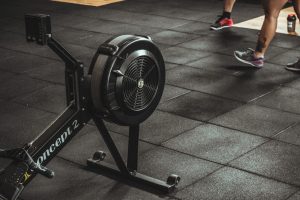
Vinyl vs Concrete Interview
While concrete is not toxic, the use of concrete floors in certain environments can allow pathogen contamination such as bacteria, mold and viruses.

Although concrete is not toxic, the concrete composite acts as a hardened sponge due to the permeability
of the surface. This allows harmful pathogens to penetrate the surface and thrive in the body of the
concrete. Pathogens continue to grow in the concrete body and can migrate back through the surface
potentially causing harm to employees.
Risk management systems for concrete floors are comprised of extensive cleaning protocols. However,
over time concrete cleaning procedures lead to a softer surface and increased cracking, creating additional
pathways for pathogens to enter the concrete matrix.
The concrete matrix mechanism is similar to that of a hardened sponge. Unlike a petri dish that can be
sanitized, concrete traps and binds materials that infiltrate it. Once pathogens penetrate the concrete
surface, even extreme disinfection methods are unlikely to fully eradicate their presence.
Pathogen growth is a common problem in grocery stores, restaurants, schools, hospitals, and retail stores
due to exposure to contaminated food, settlement of airborne bacteria, contact by shoes, and harmful
substances from spilled/dripped human fluids (Lemmen, Hafner, & Lutticken, 2004). Human exposure to
pathogens can cause severe food poisoning, strep throat, staph and skin infections, pneumonia, and blood
poisoning.
In grocery stores, departments like meat and dairy often lack the ability to maintain proper cleaning
protocols due to the size, weight, and proximity of equipment. These areas are subject to substances such
as animal blood and feces as well as bacteria including E. coli, salmonella, listeria, staphylococcus aureus,
and more. In addition, gondolas and other large fixtures used in grocery stores make implementing
proper cleaning protocols challenging. Without the execution of proper cleaning procedures, pathogen
contamination and growth is likely.
The most probable method of pathogen transmission to humans from flooring systems is through direct
contact. Other likely means of the transmission include dropping and picking up merchandise, children
crawling on the ground, stockers making contact with the ground and touching merchandise and food,
taking off shoes upon returning home, etc.
As mentioned previously, fresh concrete does not contain pathogens but is susceptible to pathogen
growth due to the nature of the concrete composite. To combat this permeability, resilient flooring
systems are typically required in hospitals, schools, restaurants, and grocery stores to minimize bacterial
growth. This is due the hydrophobicity, or ability to repel water, of the resilient flooring. These
antiadhesive surfaces are used to protect the porous concrete and impede microbial attachment to the
surface (Dancer, 2014).
When resilient flooring systems are not utilized, intensive disinfecting cleaning procedures must be
followed. These harsh chemicals lead to abrasive wear on the concrete and ultimately a softening of the
surface. This softening of the concrete surface enhances pathogen penetration and growth throughout
the entire body of the concrete.
Yes. Concrete composites release vapor and gas into the air throughout their service life.
To quantify the amount of moisture and subsequent risk to those exposed, ASTM F1869: Standard Test
Method for Measuring Moisture Vapor Emission Rate of Concrete Subfloor Using Anhydrous Calcium
Chloride can be utilized. ASTM F189 measures the amount of moisture emitted from concrete flooring
systems in pounds per 1000 square foot area per 24-hour period (ASTM International, 2016). The amount
of moisture emitted can be as high as 25 pounds per 1000 square feet in 24 hours. In this case, a 150,000
square foot grocery store would emit 3,750 pounds of moisture every day.
During concrete’s curing. and hydration period, chemical emissions are also released. These chemical
emissions produce indoor air pollution leading to multiple dangerous side effects for humans. Depending
on the chemical makeup of the concrete used, these emissions can consist of Volatile Organic Compounds
(VOCs) (Lindgren, 2010). In addition, concrete floor coatings like epoxy and sealant have been shown to
exhibit much higher levels of VOC emission than uncovered concrete. In treated concrete floors this
mechanism produces imperfections in the surface of the floor’s coating allowing bacteria and deleterious
materials through the protective layer and into the concrete floors.
As previously mentioned, there are medical risks associated with the emission of moisture vapor and
Volatile Organic Compounds. These risks include both long-term and short-term issues in both children
and adults.
Damp concrete floors have been shown to lead to symptoms of asthma in adults. As the moisture
exposure of the concrete increases so does the prevalence of asthma for those exposed (Norback,
Wieslander, Nordstrom, & Walinder, 2000).
In addition, concrete contaminated with pathogens poses health and safety risks to employees and
customers. Human exposure to harmful pathogens can cause severe food poisoning in humans resulting
in nausea, vomiting, and dehydration. Death can even occur in humans with lowered immune systems to
include the elderly and young children (Mayo Clinic).
To minimize pathogen contamination, it is imperative to densify the concrete to reduce permeability.
Through laboratory testing it has been shown that polishing of the concrete surface does not result in a
denser surface. In contrast, polished concrete that is not further coated or treated leaves the surface
exposed and results in increased cracking. This cracking leads to greater permeability, allowing harmful
substances like bacteria and fungi to penetrate the surface, subsurface, and body of the matrix. (Wang,
Jansen, Shah, & Karr, 1997).
Polished concrete is often coated with a sealant to protect the surface and resist chemical and bacterial
penetration. While this method is effective for applications such as residential floors and office buildings,
it is not capable of providing concrete able to withstand the repeated use and repetitive load patterns
commonly subjected to grocery store floors. Once this coating is compromised, pathogens can spread to the surface of the concrete under the sealer, causing delamination and facilitating growth.

While concrete is not toxic, the use of concrete floors in certain environments can allow pathogen contamination such as bacteria, mold and viruses.

In cleaning a slip resistant floor the normal surface traits that aid in slip resistance are the same that tend to hold debris.

If you run a pet-friendly or pet care business, your flooring choice can be a critical decision.
Our specialty is addressing your pain points. Allow us to show you how we may assist.